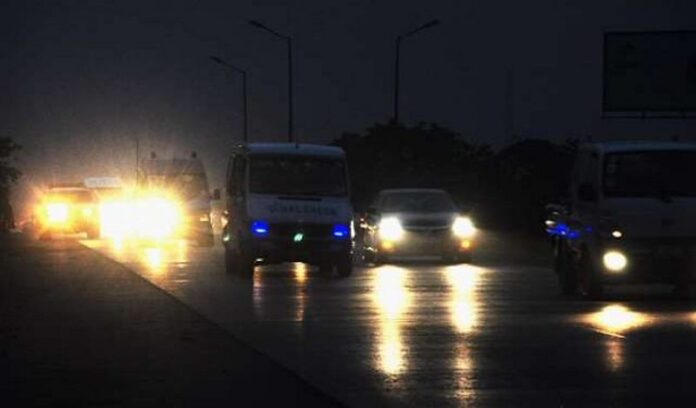
In recent years, one alarming issue that has become common across Ghana is the absence of street lights on major roads, posing serious dangers to motorists and pedestrians alike. Major highways such as the Accra to Winneba, Tema to Akosombo, Accra to Aburi, and Accra to Kumasi routes, are marked by long dark stretches of road, making night travel particularly hazardous. The situation is equally concerning inside Accra, where many neighborhoods and major streets are poorly lit. This worrying trend has significantly contributed to an increase in road accidents and fatalities, with drivers resorting to high beams in an attempt to navigate dark stretches of road, which not only blind oncoming drivers but also contributes to many fatal consequences.
The Accra to Winneba road, an essential route linking the capital to the Central Region, is notorious for its lack of street lights, especially along the more remote stretches. At night, drivers navigating this road face reduced visibility, making it difficult to see pedestrians, other vehicles, or obstacles like broken-down cars. Several fatal accidents have occurred along this route due to drivers losing control or colliding with unseen hazards.
The Tema to Akosombo road, a major corridor for commercial and private vehicles, suffers the same fate. Without adequate street lighting, long sections of this road become perilous after dark, with drivers relying heavily on their headlights to navigate the treacherous terrain. The result is a high risk of accidents, especially as drivers are often caught off guard by sudden turns, potholes, or vehicles with non-functional lights.
Similarly, the winding roads of the Accra to Aburi route, known for its sharp curves and hilly terrain, are particularly dangerous without lighting. While scenic during the day, the steep inclines and blind corners become virtually invisible at night, leading to accidents that could have been prevented with proper illumination.
The Accra to Kumasi highway, one of the most important routes in the country, is another example of a road in dire need of street lights. Despite its heavy traffic, many parts of this highway remain poorly lit, leaving drivers to battle darkness and the occasional blinding headlights of oncoming vehicles. The combination of high speeds, poor visibility, and no lighting makes nighttime travel on this road highly dangerous.
Within Accra, the nation’s capital, the lack of street lights is just as alarming. Key roads like the Spintex Road, Teshie-Nungua, and Kwame Nkrumah Circle are frequently in darkness, creating significant risks for both motorists and pedestrians. Pedestrians, in particular, are vulnerable as they attempt to cross poorly lit roads, while drivers struggle to see them in time to avoid accidents. Neighborhoods such as Adenta, Madina, and Kasoa have reported numerous cases of hit-and-run incidents on dark roads, further illustrating the dangers posed by the absence of street lights. For motorcyclists and delivery drivers, who often work late into the night, navigating Accra’s dark streets has become an occupational hazard. The combination of high-speed driving and poor lighting means that even minor miscalculations can lead to deadly consequences.
The Role of High Beams in Accidents
In an attempt to compensate for the lack of street lights, many drivers use high beams, inadvertently creating more danger than safety. High beams are designed to improve visibility for the driver using them, but they can temporarily blind oncoming drivers, making it difficult for them to see the road ahead or avoid potential hazards. This problem is particularly evident on two-lane highways such as Accra to Kumasi and Tema to Akosombo, where the glare from high beams can cause head-on collisions.
Statistics from the Motor Traffic and Transport Department (MTTD) show that poor visibility and the misuse of high beams are significant contributors to nighttime road accidents in Ghana. Drivers who are blinded by oncoming headlights often lose control of their vehicles, leading to crashes that could have been avoided with proper street lighting.
Moreover, the use of high beams is especially problematic in urban areas like Accra, where narrow streets and heavy traffic make it difficult for drivers to adjust to the sudden glare. Motorists are left struggling to navigate between dark patches of road and blinding lights from oncoming vehicles, increasing the risk of accidents.
The Human and Economic Cost of Poor Lighting
The absence of street lights on Ghana’s roads not only causes accidents but also leads to high human and economic costs. Families are left mourning the loss of loved ones, while the national economy suffers from the impact of road accidents. “According to the National Road Safety Authority (NRSA), road accidents cost Ghana an estimated 1.6% of its GDP annually, a figure that includes medical expenses, lost productivity, and vehicle repairs”(Citi News)(Citi News).
The tragic loss of life and the financial burden caused by road accidents can largely be mitigated by something as simple as installing and maintaining functional street lights. Adequate lighting would improve visibility, reduce the need for high beam usage, and allow drivers to see potential hazards in time to avoid them.
A Call for Action
The absence of street lights on key roads in Ghana is a national safety issue that requires urgent attention. The government, through agencies like the Ghana Highway Authority and the Ministry of Roads and Highways, must prioritize the installation and maintenance of street lights along major highways such as Accra to Winneba, Tema to Akosombo, Accra to Aburi, and Accra to Kumasi, as well as key urban roads within Accra.
Additionally, there should be a nationwide education campaign to inform drivers about the correct use of high beams and the dangers of blinding oncoming drivers. Law enforcement agencies should also increase monitoring to ensure that vehicles with faulty headlights are removed from the roads, as these contribute to the already dangerous conditions.
Conclusion
Addressing the issue of inadequate street lighting on Ghanaian roads is not just about improving visibility, it’s about saving lives. The combination of dark roads and the misuse of high beams has created a dangerous environment for motorists and pedestrians alike. If immediate action is not taken, the number of road accidents and fatalities will continue to rise, causing more grief for families and a heavier burden on the economy. In Accra, it’s common to say that drivers rely on memory more than sight when navigating the roads. This speaks to the poor condition of many streets, where potholes are frequent, yet inconsistent. Drivers who regularly travel these routes learn to anticipate the locations of these hazards, as visual cues are often unreliable due to poor lighting or sudden changes in road conditions. For newcomers or those who haven’t memorized these spots, the potholes can catch them by surprise, leading to sudden swerves or accidents. This issue not only slows traffic but also increases the risk of damage to vehicles and endangers lives.
The dire state of roads means that without improvements or proper lighting, driving becomes more about recollection and experience than actual safe navigation, hence the saying in “Accra we drive by memory and not by sight”
It’s time for authorities to act swiftly to ensure that Ghana’s roads are properly illuminated, making travel safer for all road users. The cost of inaction is far too high.
Story by: Gabriel Akweter



